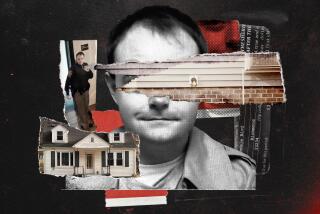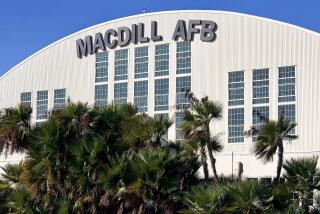For Air Force Families, Outpost Can Be Difficult Place to Call Home
- Share via
Edwards Air Force Base is on the cutting edge of aerospace technology with its high-flying experimental jets and sophisticated hardware.
But as a place to live and work for more than 21,000 people, this vast desert expanse leaves a lot to be desired, some inhabitants say.
With a remote locale 30 miles from Lancaster, and a barren, sun-baked Mojave Desert landscape, Edwards is a challenge even for those accustomed to the rigors of military life.
To be sure, opinions vary among the base’s more than 15,000 workers and 6,000 military spouses and children. Many want to be there, saying they feel safer in the base’s secure environment. Their pioneering jobs in testing and flying the most sophisticated aircraft in the world make other sacrifices worthwhile.
But most would agree that the Korean War-era housing and utility system at the 42-year-old Air Force base, the second largest in the country at 301,000 acres, offer a stark contrast to Star Wars-era weaponry valued at billions of dollars.
“I came here in July, 1988, and I found a base which I had left in June, 1977, that hadn’t changed appreciably over that period of time,” said Maj. Gen. John P. Schoeppner Jr., a former instructor pilot who returned as the base’s top-ranking officer in charge of its Flight Test Center.
“A young kid comes out here and probably says, ‘My God, this is really desolate and isolated,’ ” Schoeppner said, adding that Edwards often gives the same shock to pilots’ wives. “When they come on base for the first time they cry. And then they cry when they leave because they make so many good friends,” he said.
During his three years in charge, Schoeppner has improved crumbling roads, overhauled old utility systems, begun to renovate the base’s 4,000 housing units, and built a $3-million youth center that includes a swimming pool and snack bar. He has spent $82 million, but concedes that much remains to be done.
In many ways, Edwards is like a city, with a base commissary and exchange for shopping, its own police force, and two military jails, with one housing inmates from Edwards and elsewhere who are serving lengthy terms. There are five public schools run by the Muroc Unified School District, which serves the base and surrounding communities. There’s even a restaurant, albeit a Burger King, and a Baskin-Robbins ice cream store featuring Stars and Stripes ice cream: white chocolate with red and blue candy stars.
Edwards also has city problems, such as a deteriorating infrastructure and a drunk-driving problem that keeps the base police on their toes during weekend nights.
It takes getting used to.
“It was a big change. The first thing my wife said is, ‘There are no trees,’ ” said Staff Sgt. Greg Brown, 34, an F-16 maintenance crew chief who arrived at Edwards in January. “The isolation I think kind of gets to her. It’s not the ideal first place to bring your wife,” Brown said.
Workers such as Brown and Senior Airman John Tubb, 29, who tests electronic warfare equipment on F-15 and F-16 fighters, spend parts of their days on the base’s concrete flight line, where the desert sun bakes them and the jets. The metal gets so hot, Tubb said, that they have to wear gloves to prevent burns.
Tubb, who arrived about a year ago and has been training for his pilot’s license through the base’s Aero Club, said there are plenty of things to do at Edwards, but base residents don’t always make use of them. He and Brown said pilots sometimes just “get into a rut” and spend all their free time in their dorms.
The nearest civilization is Rosamond, about 20 miles to the west. But with only about 15,000 people, the Kern County town has a smaller day population than Edwards. And the base is even farther from the Los Angeles County cities of Lancaster and Palmdale, 30- to 45-minute drives south.
Many young Air Force personnel come to the base without cars, but quickly learn they are a necessity. No regular public bus service connects the two cities with the base. And while some on-base facilities are several miles apart, Edwards itself has only one shuttle bus route among work sites.
Thus, Greg Munson, 21, a base security police officer who recently returned from seven months in Saudi Arabia during Desert Storm, said he’s looking forward to getting a car so he no longer has to hitch a ride or walk three miles from his dormitory to the base exchange.
A repeated complaint among Edwards residents is that its base exchange, a military department store, doesn’t carry enough goods. Brown said his wife can’t find the clothes she wants. But base officials said a new and larger base exchange should be under construction by year’s end.
And because the base’s old ground-water wells have been failing and its water distribution system is crumbling, base residents have had restrictions in recent summers on outside watering. In April, a well failure led to a three-day order against drinking the base’s tap water.
Even generals aren’t exempt. Shortly after Schoeppner arrived at Edwards, aides warned him not to use his computer at home without a spike protector to guard against power surges because of the base’s faulty electrical system, which also was hampering work at base sites. The decades-old system is undergoing a $32-million repair.
Base housing, much of it more than 30 years old, is another common complaint. Some of it resembles the apartments that make up public housing in Los Angeles, with peeling paint and aging fixtures. Singles generally live in dorms while married couples have houses.
Only military personnel can live on base. Base officials gradually have been refurbishing the old houses, replacing leaky flat roofs with pitched ones, adding new swamp coolers, and redoing plumbing and wiring. But many units still need work.
Even so, the base does have an array of recreational facilities for after-hours activities. There are several swimming pools, an 18-hole golf course, a bowling alley, movie theater, gym, stables and three military clubs for various ranks.
How much socializing goes on, however, is a question, since one pilot estimated that Edwards has about seven times as many men as women.
Capt. Ken Green, 32, an F-16 avionics engineer who is married with three children, lives in one of the redone houses. He says his family is happy with it and the sheltered lifestyle at Edwards since moving from the South Bay more than three years ago. “For our family with young children, this is a good place to be,” he said.
Likewise, Capt. Ed Cabrera, 31, an F-16 pilot who with his wife bought a house near Lancaster, says he too likes Edwards. But Green acknowledged that their jobs testing the nation’s front-line jet fighters might be a reason for their upbeat view of base life.
Tanya Altenbernd, 23, who is in charge of the base’s gate guards, said she hears a lot of griping about the base. But after being evacuated from the Philippines recently after Mt. Pinatubo’s eruption, Altenbernd said Edwards suits her fine. “I’m one of the lucky ones. I wanted to come,” she said.
More to Read
Inside the business of entertainment
The Wide Shot brings you news, analysis and insights on everything from streaming wars to production — and what it all means for the future.
You may occasionally receive promotional content from the Los Angeles Times.










